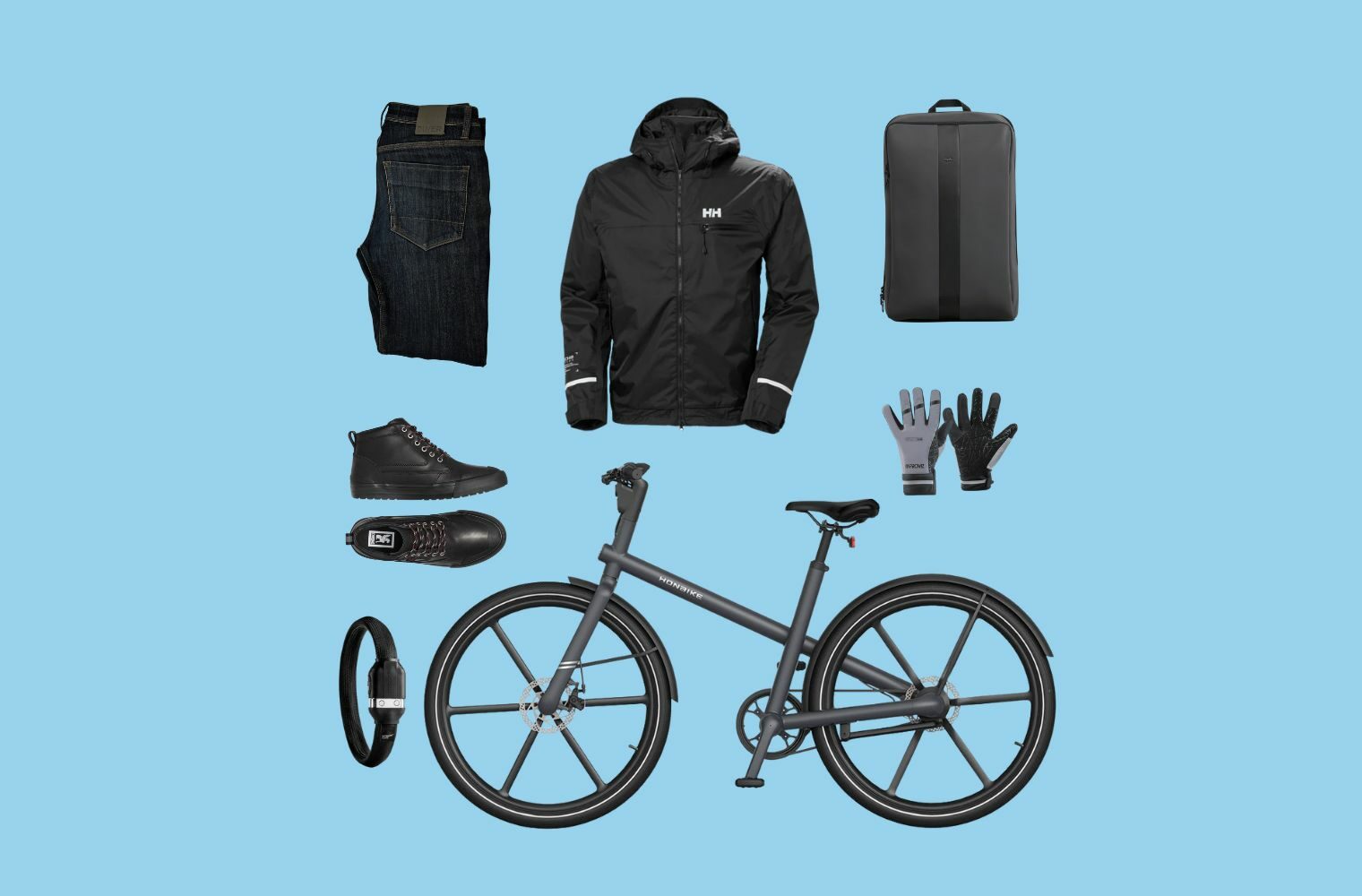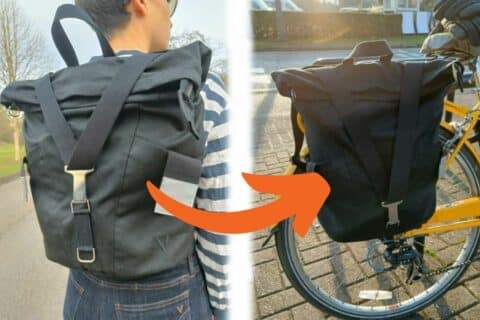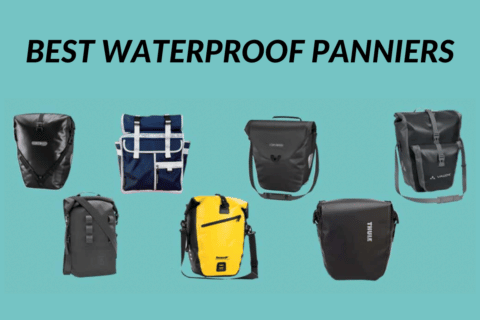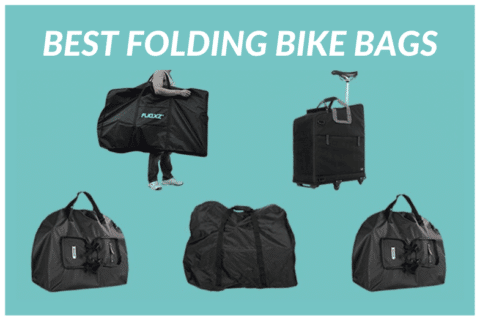This post may contain affiliate links, which help to keep Discerning Cyclist rolling. Learn more.
If you’re keen to leave the car at home and avoid public transport when getting to work, commuting via bike can be a great way to provide regular exercise, no matter how quick or long the journey takes.
Read More:
On your commuting checklist, you’ll likely have the usual suspects – helmet, lights, waterproofs, a lock – but probably the most important consideration is the thing that carries all your gear: your bag.
But the question is, what’s the best type of bag for bike commuters?

Bike Commuting Bag Considerations
Here are some simple factors to take into account when thinking about what makes a good cycling backpack for you:
- How much space do you need? (e.g. for your laptop/books/any other equipment)
- How heavy are the belongings you’re going to carry?
- What’s a higher priority for you – functionality or comfort?
- What type of bike do you have? (e.g. does it have pannier racks? How big and thick are its wheels?)
- How wet, either through rain, snow or your own sweat, is your bag likely to get?
- How long is the distance you’ll need to travel to and from work?
What is the Best Type of Bag for Riding a Bike?
There’s no shortage of choice in this department – backpacks, messenger bags, tote bags, panniers and handlebar bags may all be best suited to your commuting needs.
Below, we’ll take a closer look at all five of them, and which bag we’d most recommend for each:

Cycling Backpacks
The “Marmite” of cycling bags, many commuters seem to have a love/hate relationship with backpacks. They simply sit on your back, with no extra fixings necessary, and no effect on the weight on the bike, either.
Can you cycle with a backpack? Yes, and in many cases it’s the most convenient and practical option, especially if you’re lugging a great deal of belongings to and from work.
So what’s the downside of cycling with a backpack? Well, many people will point to the dreaded “sweaty back”, but this shouldn’t be a problem if your bag is light and even if you are carrying a heavy load, the impact will be minimised by getting a good quality rucksack with a suitably ventilated back for cycling.
For me, I typically cycle with a backpack. This might be controversial, but I believe there are three magic rules for when a backpack is the best option for commuting by bike:
- It’s for a short commute (<4 miles)
- Your bag isn’t too heavy (<15lbs)
- It’s not too hot (<25°C )
Here, we’ll look at the different types of backpack available for the different types of commuter, as well as offering some of our own personal favourite. Let’s take a look:
Backpacks for Cycling: Pros + Cons
The advantages of a good cycling backpack are that they can certainly carry a lot of gear, don’t need any special racks added to your bike, are easy to take on and off, and require no transition when you get off your bike.
Yet what also makes them so divisive among cyclists is the notorious ‘sweaty back’ they can inflict on you, as well as the fact that, if you have a fair bit of weight in your bag, it hardly allows for the most comfortable of commutes.
| Bike Backpack Advantages | Bike Backpack Disadvantages |
|---|---|
| Carry a big load | Can cause sweaty back after riding |
| No special racks/clips/straps | Heavy weights can mean less comfort |
| Easy to take on and off | Can cause aching shoulders |
| No transition when getting off bike | Slower reactions and possible visual impairment |
Best Chrome Backpack for Commuting:
Chrome Barrage Cargo Backpack

- 8 colours available
- Durable and 100 per cent waterproof
- Ergonomic shoulder strap
For a good, solid backpack which looks great in a variety of colours, this Chrome commuter backpack fits the bill and more. Indeed, if you’re looking for the best cycling backpack for commuting, this could well be it.
A 100% waterproof backpack, this is their most durable design yet, built with an abrasion-resistant nylon shell to boot. Plus, there’s also a comfortable shoulder strap with moulded back panel, as well as a sternum strep with a mini belt buckle.
It also fits a 15″ laptop and have a volume of 18L when the top is rolled down. The barrage backpack weighs in at just 3.35lbs.
And, if you want extra visibility in the dark, make sure to check out the Night model which is packed with reflective detailing.
Want to read more? Check out our full review of this superb Chrome waterproof commuter backpack here.
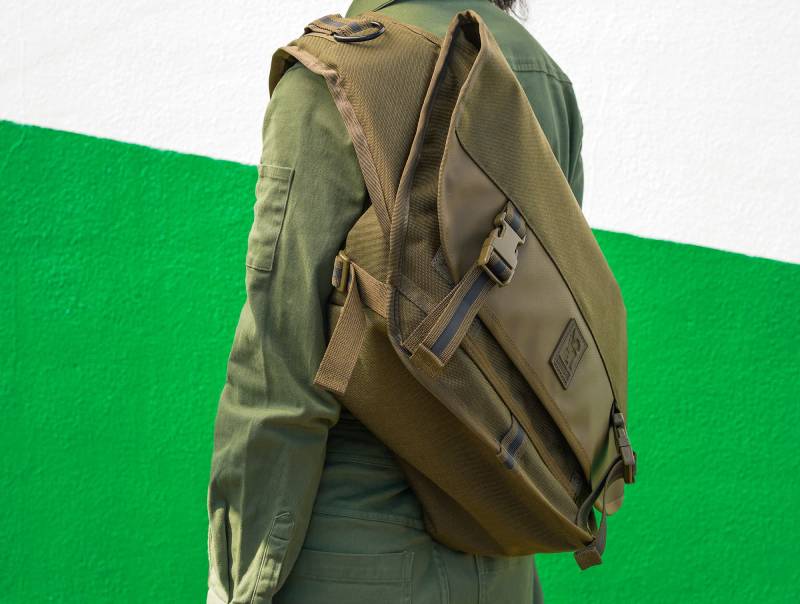
Bike Messenger Bags
A typically smaller bag but great for carrying your belongings, just sling a messenger bag strap over your head (or clip it around your chest) and you’re good to go.
Cycling Messenger Bags: Pros + Cons
Just because they may not usually be as big as other bags doesn’t mean they don’t have plenty of room. Most good messenger bags should still store a laptop and plenty of files, with easy access guaranteed even without taking them off – making them great bags for students or office workers.
As well as their simple setup, their smaller surface area also works to its advantage in a way, in that during hotter commutes, there will be less of a build-up of sweat than with, say, a cycling backpack.
Though, this isn’t always the case; especially if your messenger bag is particularly wide, you can still end up with a back drenched in sweat, while on longer rides they can contribute to back pains.
| Messenger Bag Advantages | Messenger Bag Disadvantages |
|---|---|
| Good for shorter rides | Wider bags can still cause big sweat build-up |
| Professional look | Longer rides can cause back pains |
| Easy to access bag contents | Heavy loads can cause aching shoulders |
| Generally less sweat build-up | Can move when riding if no stabilisation clip is included |
How to Wear a Messenger Bag while Cycling (So It Doesn’t Move)
Another common problem is that a messenger bag slips and slides around when cycling, which can make it hard to focus on the road ahead if you’re constantly feeling your bag and its contents moving all the while.
However, the best messenger bags around (such as those available from Chrome) also have a ‘stabiliser clip’ which stops the bag from moving around as you ride.
Best Chrome Messenger Bag for Commuters:
Chrome Citizen Messenger Bag

- Available in six different colours
- Reflective features for visibility in darkness
- Quick-release buckle
Not only is this the best commuter messenger bag for its variety of striking colours, but also for the way it offers excellent visibility at night thanks to its reflective panel and trims.
This medium-sized bag also possesses a quick-release seatbelt buckle, an ergonomic shoulder strap and a stabilizing strap, so that you shouldn’t find this messenger bag struggling to stay still as you ride.
If all of that wasn’t enough, it also comes with a weatherproof tarp liner, with a durable nylon shell, so you it’s suitable no matter how treacherous the elements may be.
Backpacks v Messenger Bags for Bike Commuting
| Backpack Benefits | Messenger Bag Benefits |
|---|---|
| Carry a big load | Good for shorter cycles, rides with lots of stops, or if you don’t have a lot to carry |
| No special racks/clips/straps | Professional look and plenty of storage room |
| Easy to take on and off | Simple setup, easy to access bag contents |
| No transition when getting off bike | Generally less sweat build-up than other bags |

Cycling Tote Bags
One of the most in-vogue cycling bags currently, tote bags have large parallel handles coming up from the inside of the bag, and can be carried in your hand, on your shoulder, or in a cyclist’s case, on one of the handlebars.
Bike Tote Bags: Pros + Cons
It’s not hard to see why tote bags are so fashionable – they look and feel great, and boast a wide array of colours and materials (though, usually cotton) to choose from.
In terms of cycling, they can be great for shorter commutes, or bike roads to pick up a few groceries. Some even use them as their personal handbag as opposed to handbags. Plus, especially compared to plastic bags, tote bags offer a better alternative, at least as far as the environment is concerned.
That said, tote bags risk getting in your way if they dangle from your handlebars. Not only could they throw you off-balance off, but they may also bounce against your wheel, damaging both bike and bag in the process.
| Tote Bag Advantages | Tote Bag Disadvantages |
|---|---|
| Good for shorter commutes | Dangerous if dangling from handlebars |
| Better for the environment | Could throw you off-balance |
| Stylish look | Could damage bike by hitting wheel |
| Ideal for storing smaller belongings |
Best Chrome Tote Bag for Cycling:
Chrome Tote Backpack: BLCKCHRM 22 LAKO 3-WAY

- Made of lightweight, durable 22X nylon laminate
- Padded laptop sleeve
- Best bike commuter bag for versatility
What makes this the best commuter tote bag? Well, for a start, its handles mean it can impressively and easily convert into a backpack if you so wish.
What’s more, this Chrome commuter bag offers advanced lighting and is made of tough, sturdy 22X nylon laminate, while its padded laptop sleeve can fit computers as big as a 13″ Macbook Pro.
It offers plenty of wet/dry internal compartments, too, as well as a quick-access phone pocket. Ideal for cycling to work, the shops, the gym – almost anywhere, in fact.

Bike Pannier Bags
Probably the most common commuter bag after backpacks, a pannier bag sits on a rack to the bike’s rear, over the back wheel.
Cycling Pannier Bags: Pros + Cons
Many cyclists swear by pannier bags as they make the bike carry the weight of the bag’s contents, rather than you, the rider.
Indeed, the main advantage of panniers is undoubtedly the extra weight they can carry, without adding to the strain on your shoulders. This makes them ideal for carrying not just necessities for work, but also shopping, or a change of clothes, for instance.
But despite this enhanced balance or freedom of movement, you’re making your bike heavier with a pannier bag. This consequently means more pedal power on your part – good luck up those hills if that is the case.
Plus, with extra storage comes extra cost – not just monetary, even if panniers are more expensive than a backpack generally, but also physically, given they require more effort to install and remove, too.
| Pannier Bag Advantages | Pannier Bag Disadvantages |
|---|---|
| Much more room for storage | Makes bike heavier, demands more pedal power |
| No extra weight on shoulders | Typically more expensive than backpacks |
| Doesn’t restrict the riders body | Less straightforward to install and remove than backpacks |
Best Chrome Pannier Bag for Commuters:
Chrome Barrage Pannier Bag

- Super stylish cycling pannier bag
- Handle and shoulder strap
- Locking three-point system to fit most bike racks
This pannier comes with plenty of handy functions, not least a locking three-point system which will fit most bike racks.
In addition, there’s an expandable cargo net for even more storage room, as well as handle and shoulder strap and welder waterproof liner with a durable nylon shell.
And it’s up there as arguably the best commuter laptop bag, with a sleeve which can fit a 13″ Macbook Pro with no issues.
Bicycle Handlebar Bags
This one’s pretty self-explanatory. There are no prizes for guessing where you’ll find a handlebar bag; they’re a great way to store your valuables safely while maintaining the ability to quickly access them if need be.
Bike Handlebar Bags: Pros + Cons
Indeed, handlebars possess excellent ease of access, with everything you put in them virtually always within hand reach without bringing the bike to a standstill simultaneously.
This makes them highly practical for both quick commutes or shopping trips, or longer, extended cycling tours. As well being lighter and more stylish than most, most them also boast waterproof functions, too.
That said, they also tend to have a limited amount of space – they’re good for carrying bits and bobs, probably won’t fit a laptop, for instance.
They also lack versatility as well as capacity, have a higher cost, are harder to repair if damaged, and their higher weight positioning can also cause problems.
| Handlebar Bag Advantages | Handlebar Bag Disadvantages |
|---|---|
| Ease of access | Limited capacity |
| Light and stylish designs | Not particularly versatile |
| Easy to keep an eye on | Can be costly |
| Ideal for lots of smaller belongings | Higher weight positioning |
Best Chrome Handlebar Bag for Commuting
Chrome Doubletrack Handlebar Sling

- Quick-access mesh side pockets
- Durable nylon shell
- Hook-and-loop handlebar attachment system
Finally, this handlebar bag doubles up – either ride with it on your bike, or sling it on your back thanks to its useful shoulder strap.
Its mesh side pockets and magnetic one-handed flap closure ensure ease of access, while its durable nylon shell with 70D poly liner means this is a bag made to last.
In addition, it also operates with a hook-and-loop handlebar attachment system, and its stowable crossbody strap means you can keep wearing it around your waist even after finishing your commute.
What is the Best Type of Cycling Bag?
The best bag for cycling commuting really does depend on a multitude of factors: namely your own personal needs, your bike and your commute, of course.
I personally prefer to ride with a Chrome backpack as my gear is never too heavy (laptop, lunch and gym gear on a “heavy” day). But if you want your bike to do the work for you , then perhaps a stylish pannier bag is your best option.
But what do you think? Vote below for your favourite bag for bike commutes:
Read More:




